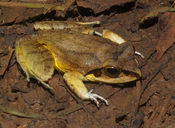|
Description
M 35 mm. Head often somewhat broader than in the A. madagascariensis complex but much less broad than in A. laticeps. Tibiotarsal articulation reaches between nostril and snout tip. Hands without webbing, foot webbing 1(1), 2i(1.5), 2e(0.5), 3i(2), 3e(1), 4i(2.5), 4e(2), 5(0.5). Dorsal skin smooth. Greyish brown to reddish brown. Breeding males bright yellow. Aglyptodactylus have two typical black markings laterally on the snout which are only rarely absent, and a small pair of black markings in the inguinal region. Distribution and Habitat
Country distribution from AmphibiaWeb's database: Madagascar
Endemic to Madagascar. Found at Ankarana (Campement des Anglais), Antranopasasy, Berara, Kirindy, Manongarivo, Montagne des Français, Tsingy de Bemaraha. Occurs below 300m asl (IUCN 2008).Life History, Abundance, Activity, and Special Behaviors
An explosive-breeding species in dry deciduous forests in the west. Can be locally common and encountered, outside of the breeding season, on the forest floor during day and night.
Calls: Slow series of 1-3 rather long pulsed notes.
Frogs of the genus Aglyptodactylus are terrestrial frogs which can be observed during the day jumping in the leaf litter of rainforest or western dry deciduous forest. Often extremely explosive breeders, they gather after heavy rains during the day in temporary waters where they reproduce.
Comments
Taken with permission from Glaw and Vences (2007).
References
Datong, Y., and Shunqing, L. (2004). Cynops cyanurus. In: IUCN 2008. 2008 IUCN Red List of Threatened Species. www.iucnredlist.org. Downloaded on 11 March 2009.
Glaw, F., and Vences, M. (2007). Field Guide to the Amphibians and Reptiles of Madagascar. Third Edition. Vences and Glaw Verlag, Köln.
Originally submitted by: Frank Glaw and Miguel Vences (first posted 2008-12-04)
Edited by: Kellie Whittaker (2010-07-19)Species Account Citation: AmphibiaWeb 2010 Aglyptodactylus securifer <https://amphibiaweb.org/species/5405> University of California, Berkeley, CA, USA. Accessed May 22, 2025.
Feedback or comments about this page.
Citation: AmphibiaWeb. 2025. <https://amphibiaweb.org> University of California, Berkeley, CA, USA. Accessed 22 May 2025.
AmphibiaWeb's policy on data use.
|
